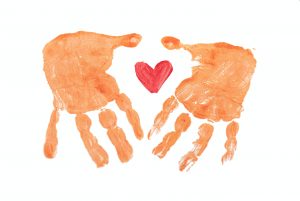Gratitude is an essential component of mindfulness, an excellent practice for addressing anxiety in kids. Practicing gratitude has been shown to have multiple health benefits, but those benefits take time to appear in the body, which is why it’s vital to spread gratitude activities throughout the year.
Try these seven gratitude activities to do together as a family.
1. Make Talking About Gratitude a Habit
Sometimes, no fancy activity is necessary. If you make talking about gratitude a daily occurrence, it will become a habit and the kids will start talking about it on their own. Sometimes, though, you may need a conversation starter to kick things off, so you can use the gratitude game printable below to generate a discussion at the dinner table or during a family meeting. Everyone can talk about the same prompt, or everyone draws something different. Either way, everyone gets to share!
2. Volunteer in Your Community

Volunteering is a great family activity. Show kids how to be grateful for their community by participating in a community clean-up, working in a community garden, or helping at a local food bank as a family. Try to make this a routine activity you do all year long to avoid kids thinking volunteering is something you only do around the holidays.
3. Leave Chore Thank You Tags
We often spend more time scolding our kids for doing something wrong rather than praising them when they do something right. Research shows kids should hear five positive comments to every negative one.
Make saying thank you for all the good your kids do easier with the pre-printed thank you tags below. Kids can even get in the act to thank each other or you if you leave the tags somewhere they can access them. Who knows? Your kids may end up doing their chores more readily if they know you see and appreciate them.
4. Thank a Neighbor With a Treat
When your neighbor helps you out with a yard work chore or lends you the tool you need to finish a repair job, thank them by baking something special and delivering it as a family or inviting them over for a family dinner one night.
You can also work with your kids to help an elderly neighbor who needs it. Pick up their groceries, mow their lawn, or spend a few hours with them on Saturday. By doing something nice for them, your kids will learn to help others, giving them the chance to receive gratitude rather than give it. If they know how good it makes them feel to be thanked, they’ll be more likely to engage in gratitude with others in the future.
5. Thank Your Pet

Don’t leave out the family pet! Instead, take time to focus on your pet as a family, whether by giving a good belly rub, going on a family walk, or throwing a toy. During the activity, talk about why you’re grateful for your pet. Maybe the dog played outside with the kids after school, or perhaps the cat took a nap with one of them. Maybe you’re just grateful they didn’t chew your favorite shoes. Whatever it is, verbalize it so kids hear how to express gratitude. This is great practice for talking with a real person since often kids are more comfortable expressing their gratitude with a pet at first.
6. Give Someone a Couch Potato Night
As a family, pick a day to give someone the night off from all their responsibilities. Maybe your partner had a rough day at work, so you and the kids tell him to put their feet up and watch the game while you divvy up who takes out the trash, walks the dog, or mows the grass. Be sure everyone tells the person something they did that week they are grateful for!
7. Have a Date Night

This isn’t exactly something you do as a family, but by modeling taking time for your relationship, you’ll show your kids the importance of being thankful for the people in their lives. Set aside one evening a month and hire a sitter or drop the kids off at a relative’s for the evening. Then use the date night flow chart below to plan the perfect date to show your partner how grateful you are to have them in your life.
Just like building your child’s cognitive development, learning gratitude takes time. Make it a fun family activity, and don’t be afraid to switch up the gratitude activities to find what works for your family.






